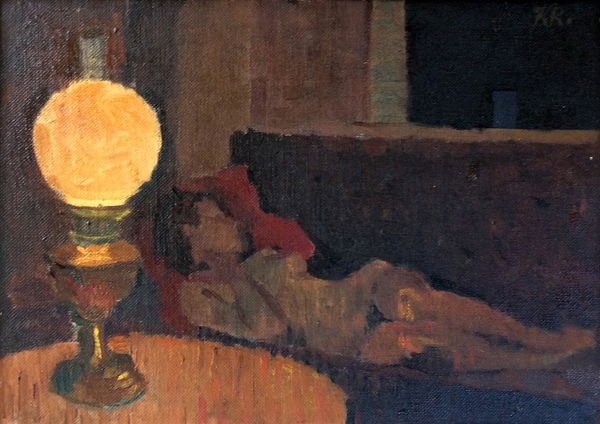Exhibited: The Leceister Galleries, November 1946.
Lamplight was included amongst the 61 pictures exhibited at the Leceister Galleries in November 1946, Rowntree's first one-man show, comprising works painted between 1938 and 1946. Reviewing the show The Times commented, ‘he has a remarkable gift for making a cheerful and attractive composition out of commonplace objects’ but ‘there is not much room for subtlety in his approach.’ This was surely to ignore the allure of Rowntree’s combination of subject and technique, evoking the visual stimulus of things seen as surprising moments of beauty, from bright sunlight on a simple tabletop still
life to a sudden shower of rain across a dark and featureless landscape. It is an
epicurean enjoyment of things for their own sake, accepting them as they are and
offering this quietest but sensual vision to others.
According to Eric Newton, who evidently wanted something different, the 11
painters in another Wildenstein mixed exhibition in January 1945 could be
‘arranged from right to left, with Edward Le Bas on the right, linking up with
Bonnard and the Impressionism, and Kenneth Rowntree on the left, vaguely
holding hands with the British tradition of illustrative painting.’ This, as Newton
went on to explain, was essentially the Euston Road School ten years on, and
‘placid refinement is the keynote.’ This is a negative way of seeing Rowntree as a
figure of compromise. The introduction text to a group exhibition at the City of
Leicester Gallery early in 1946 by Trevor Thomas got closer to understanding
the strength of his work as ‘a desire to return to the primitive … a longing for an
original innocence before taste and feeling were polluted and vitiated by
industrial living.’ Yet while Rowntree spent much of the war painting relics of
older times, he was not simply guided by nostalgia, and seldom edited out the
signs of modern life when these occurred, relishing the jolt of anachronism and
geometrical order they could bring. He did not pursue primitivism to the extent
of breaking the conventions of scale and perspective, and his self-aware
innocence should perhaps be attributed rather to a combination of personal
preference and belief with a general enthusiasm for the fresh vision of folk art
shared by many artist contemporaries, Alan Powers, Kenneth Rowntree A Centenary Exhibition, p 36

